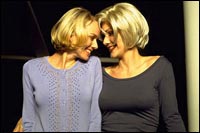 |
|
|
|
It is true that the portrayal of lesbian
love in Delphine et Hippolyte is dark and negative.
Lesbianism is like a dreadful narcotic. The lovers have “yeux
amortis” [“deadened eyes”]), “l’air brisé”
[“look broken”] and indulge in “la morne volupté”
[“mournful voluptuousness”]. (22) The love of Delphine
and Hippolyte is awfully ambivalent. The young lover Hippolyte
suffers harrowing remorse. She is haunted by “de noirs
bataillons de fantômes épars” (“black battalions of
scattered ghosts”] (23) The women have performed “une
action étrange” [“a strange act”] (24). The dominating,
ravenous Delphine is likened to “un animal fort qui surveille
une proie” [“an animal who observes its prey”]
(25). She is vampiric. Hippolyte is “marquée avec les dents”
[“marked with her teeth”] (26). Their love is sinful.
They are damned. The lesbian is identified as nothing less
than evil. Whether it is agreed that Baudelaire changed his
attitude toward lesbian love, it remains problematic. As the
lesbian is conflated with an elite, creative masculinity,
the lesbian is nothing other than a product of a masculinist
imagination in Baudelaire’s poetry. Sapho is identified as
male (27). Although Baudelaire may depict the lesbian as beautiful,
sensual and transgressively evil, his denial of the femininity
of his lesbian lovers and in his hatred of maternal identity
in general reveals a powerful misogyny. In Baudelaire’s poetry,
the lesbian remains an exceptionally ambivalent figure.
In Mulholland Drive, David Lynch depicts lesbian love
as singularly sensual and tempestuous. It expresses a unique
emotional power. It is beautiful and tragic. As the kisses
of Lesbos coalesce with tears, the lovers of Mulholland
kiss and cry copiously. Further, lesbian love in Mulholland
is both pure and evil. It is extreme. It is other. Lynch’s
poetic dualistic vision conforms to Baudelaire’s vision of
women as both pure and devilish. In the magical scene at Silencio
the women’s love exists outside the time and space of Hollywood.
It is also aligned to the occult. Thus, David Lynch’s lesbian
lovers exhibit a paradoxical Baudelairean character. It may
also be revealed that Lynch’s depiction of lesbian love is
politically questionable. He similarly employs such images
of the lesbian as a male fetish and portrays her as extremely
sexual, sexually violent and violent. The beautiful Betty
transforms into the evil Diane. In his identification of the
figure of the lesbian with sexual violence and violence in
general, we may ask if Lynch obscures male sexual violence.
The cultural demonisation of female violence and the identification
of female violence with so-called perversion has historically
served to mask universal male violence. Does Lynch sustain
such misogynist myths ? Equally, does his portrayal of
lesbian love reproduce poetic associations of female homosexuality
with darkness, however seductively fetishised as a great perverse
other ? As evaluated above, in consideration of Lynch’s
iconographic Hollywood representations of woman and female
homosexual love as pathological, I do not think that Lynch
regressively reproduces negative imagery in its allusion
to poetic influences which phallicise and demonise the figure
of the lesbian. Perversion for Lynch is always inherently,
constantly ambivalent. Lynch is neither a moralist or misogynist.
He does not ultimately damn his heroines to hell. Lynch evokes
and plays with poetic conceits. In demonstrating Baudelaire’s
modernist influence in his modern portrayal of lesbian love,
Lynch binds his poetic vision to the avant-garde notions and
images of the past while applying a post-modern consciousness.
What lingers after viewing Mulholland is its Baudelairean
sensuality. However, Lynch does not portray Diane as a Satanic
creature. She is neither a vampiric nor a masculine lover.
Further, if there is an evil icon in Mulholland, it
is Hollywood. Indeed, Betty and Rita’s love-making could be
said to make up the purest moments in Mulholland Drive.
Their love transcends a Hollywood characterised by artifice
and corruption. In making their love natural and authentic,
Lynch arguably subverts the Baudelairean conceit of the lesbian
as the embodiment of artifice. Moreover, it is the romantic
“otherness” rather than the transgressive quality of lesbian
love which Lynch celebrates. Ultimately, what dominates Mulholland
is its tragic romance. Diane’s decline is depicted as dreadful
and sorrowful.
|